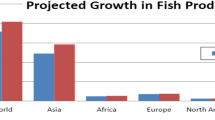Abstract
Squid is the most diversified member of marine cephalopod mollusk and it is a highly priced crustacean. The authenticity of species is a big issue for food authorities, while given wrong species labels representing the commercial fraud to the consumers, hence this implies substitutiion of one species by another of cheap commercial value. Each squid has got its own features to accurately classify the species. Color, shape, and texture features are very important in classifying the squid species. The most dramatic differences were observed in the shape variation of squid species, which are mantle length, mantle width, head length, head width, fin width, and total length. Not only the shape features are sufficient to identify the squid species but the color and textural features are also considered for classification. The color and texture features of squids are correlation, homogeneity, entropy, R mean, standard deviation, G mean, standard deviation, skewness, B mean standard deviation, and skewness of B. While considering the color, shape, and texture features of squid images, some uncertainty can be found on these features. To avoid uncertainty soft computing techniques have become more popular. In different soft computing paradigms, more flexible and uncertainty-avoiding method is fuzzy logic. Hence, in this work, we developed a feature-based fuzzy inference system design to classify squids into 15 classes. The classifier in this case operates as a Mamdani type fuzzy inference system used for the classification of squid species.
Access this chapter
Tax calculation will be finalised at checkout
Purchases are for personal use only
Similar content being viewed by others
References
Muchlisin ZA, Zulkarnaini B, Purnawan S (2014) Morphometric variations of three species of harvested cephalopods found in northern sea of aceh province, Indonesia. Biodiversitas J Biol Divers 15(2):142–146. ISSN: 1412-033X. https://doi.org/10.13057/biodiv/d150205.
Lockley AK, Bardley RG (2000) DNA-based methods for food authentication. Trends Food Sci Technol 11:67–77
Kurhe AB, Satonkar SS, Khanale PB (2011) Soft computing and its applications. BIOINFO Soft Comput 1(1):05–07
Malik V, Gautam A, Sahai A (2013) Satellite image classification using fuzzy logic. Int J Recent Technol Eng (IJRTE) 2(2). ISSN: 2277-3878
Moallem P, Somayeh Mousavi B (2013) Gender classification by fuzzy inference system. Int J Adv Robotic Syst 10(89)
Kuncheva LI (2008) Fuzzy classifiers. Scholarpedia 3(1):2925. https://doi.org/10.4249/scholarpedia.2925
Ingole K, Katole K, Shinde A (2013) Crop prediction and detection using fuzzy logic in matlab. Int J Adv Eng Technol 6(5):2006–2012. ISSN: 2231-1963
Borkar AD, Atulkar M (2013) Fuzzy inference system for image processing. Int J Adv Res Comput Eng Technol (IJARCET) 2(3). ISSN: 2278-1323
Shashikanth CC, Kulkarni P (2013) Region based image similarity using fuzzy based sift matching. Int J Comput Appl 67(3). ISSN: 0975-8887
Bai Y, Wang D (2006) Fundamentals of fuzzy logic control–fuzzy sets, fuzzy rules and defuzzifications
Acknowledgements
This Research work is done under DBT project, New Delhi.
Author information
Authors and Affiliations
Corresponding author
Editor information
Editors and Affiliations
Rights and permissions
Copyright information
© 2021 The Author(s), under exclusive license to Springer Nature Singapore Pte Ltd.
About this paper
Cite this paper
Himabindu, K., Jyothi, S., Mamatha, D.M. (2021). Feature-Based Squids Classification Using Fuzzy Logic. In: Jyothi, S., Mamatha, D.M., Zhang, YD., Raju, K.S. (eds) Proceedings of the 2nd International Conference on Computational and Bio Engineering . Lecture Notes in Networks and Systems, vol 215. Springer, Singapore. https://doi.org/10.1007/978-981-16-1941-0_3
Download citation
DOI: https://doi.org/10.1007/978-981-16-1941-0_3
Published:
Publisher Name: Springer, Singapore
Print ISBN: 978-981-16-1940-3
Online ISBN: 978-981-16-1941-0
eBook Packages: Intelligent Technologies and RoboticsIntelligent Technologies and Robotics (R0)




